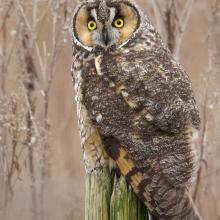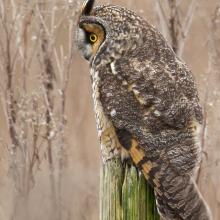

Join BirdNote tomorrow, November 30th!
Illustrator David Sibley and actor H. Jon Benjamin will face off in the bird illustration battle of the century during BirdNote's Year-end Celebration and Auction!
Nocturnal Long-eared Owls tuck up in dense stands of trees across North America and temperate Europe and Asia. They may form communal roosts up to a hundred in number in the winter. After dark, their low-pitched hoots carry for half a mile, as they cruise low over fields, listening intently for their rodent prey. In order to help boost dwindling numbers, wildlife advocates suggest preserving open, fallow fields.
BirdNote®
Long-eared Owls Fly at Night
Written by Bob Sundstrom
This is BirdNote.
[Long-eared Owl hoots, https://www.xeno-canto.org/552302, 0.24-.30]
The low-pitched hoot of a Long-eared Owl can carry for half a mile. The bird flies low across open fields in the dark, listening intently for rodent prey. When it’s not hunting, the owl perches in a dense stand of trees.
[Long-eared Owl hoots, https://www.xeno-canto.org/552302, 0.24-.30]
It’s a slender owl with two long, feather tufts sticking straight up like ears on top of its head. Its muted feathers may act as camouflage with the surrounding leaves, but you can’t miss this owl’s intense yellow eyes and orangey-brown face.
[Long-eared Owl “bark” call, https://macaulaylibrary.org/asset/145839211#_ga=2.158728633.2008419936…, 0.01-.04]
Long-eared Owls live across North America and temperate Europe and Asia. During the spring mating season, males display to females in zigzag flight while clapping their wings together.
[Long-eared Owl, wing claps, https://www.xeno-canto.org/411820, 1.01-1.06]
In winter, the owls may form communal roosts of up to a hundred birds.
In some areas, Long-eared Owl populations are declining due to habitat loss. Open farm fields where the owls once hunted have reverted to deciduous woods or morphed into housing tracts. Wildlife advocates suggest helping the owls by preserving open, fallow fields and by avoiding pesticides that find their way into the owls’ prey.
[Long-eared Owl hoots, https://www.xeno-canto.org/552302, 0.24-.30]
For BirdNote, I’m Mary McCann.
###
Some bird sounds provided by The Macaulay Library of Natural Sounds at the Cornell Lab of Ornithology, Ithaca, New York. Bark call, ML145839211, recorded by Andrew Spencer. Other sounds provided by Xeno-Canto.org. Hoots, XC552302, recorded by Jarek Matusiak. Wing-claps, XC411820, recorded by Marc Anderson.
Senior Producer: John Kessler
Production Manager: Allison Wilson
Editor: Ashley Ahearn
Producer: Mark Bramhill
Associate Producer: Ellen Blackstone
BirdNote’s theme music was composed and played by Nancy Rumbel and John Kessler.
© 2021 BirdNote January 2021 Narrator: Mary McCann
ID#: LEOW-01-2021-01-13 LEOW-01
https://portal.ct.gov/DEEP/Wildlife/Fact-Sheets/Long-eared-Owl
https://www.owlresearchinstitute.org/long-eared-owl-conservation
https://www.pgc.pa.gov/Wildlife/EndangeredandThreatened/Pages/Long-Eare…
https://birdsoftheworld.org/bow/species/loeowl/cur/conservation
https://www.allaboutbirds.org/guide/Long-eared_Owl/lifehistory





